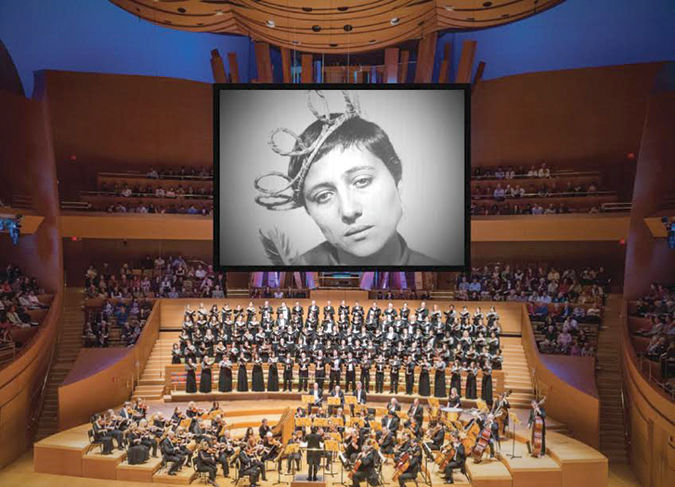“The Passion of Joan of Arc,” the 1928 silent film by Danish director Carl Dreyer, has been hailed by critics as among the top ten greatest movies ever made.
The film was shot in black and white on a huge concrete set that re-created the Rouen castle. Dreyer had holes dug in the ground so that his cameramen could film from below, showing extreme, often grotesque, close-ups of the actors’ faces. With her shaved head and huge expressive eyes, Renée Falconetti depicts Joan’s harrowing ordeal — the terrifying interrogation, the beseeching prayers, the burning at the stake — from a place so deep within that at some point we feel our souls on trial with her.
"There were questions, there were answers — very short, very crisp,” Dreyer observed. “Each question, each answer, quite naturally called for a close-up.... The result…was that the spectator was as shocked as Joan was, receiving the questions, tortured by them.”
Other factors conspire to make the film haunting. Falconetti had a nervous breakdown after playing Joan and, years later, committed suicide. The final cut, lost for decades, showed up in 1981 in a janitor’s closet at a mental institution in Oslo, Norway.
On Oct. 19, the L.A. Master Chorale will present the Disney Hall Premiere of Richard Einhorn’s “Voices of Light/The Passion of Joan of Arc,” based on and performed to Dreyer’s legendary film, which Einhorn first saw in 1984. He spoke to me by via phone from New York City:
“In the early ’80s, I was wanting to write a piece that explored the complicated feelings many people have when it comes to religion. There’s a search for transcendence, for order, for meaning. There’s a search to understand the universe. There are ways that religion has been bent to many other purposes.
“I narrowed the search to Western religions, took a trip to Eastern Europe, and found a lot of my friends in what was then Czechoslovakia had converted to Catholicism. They were very, very serious about their practice, which in part was a way of expressing dissent to their unbelievably oppressive government. They gave me various mystical writings: Thomas Merton, St. John of the Cross. Religious experience can be joyful but, especially through the eyes of the Catholic mystics I started to read, it can also arise from, or generate, extreme pain.
“Someone suggested Joan of Arc as a subject, which at first seemed a really bad idea. I saw her as a kind of plaster saint. Every young girl goes through a Joan of Arc phase.
“Then I came back to New York and saw Dreyer’s film. I walked out of the theater shattered, struck. I realized, Oh, this is my subject. This is my girl. I can do something with this.
“A tremendous amount of research came afterward, but by the time I had walked to the subway, I knew exactly what I wanted to do.
“The one thing everyone knows about Joan of Arc is that she heard voices. So right away I knew I wanted to do a vocal piece. The movie is all about the tension between a woman’s private vision of God and the more public, male, institutional Church. I knew I wanted to tell the story from the woman’s point of view, so I happened upon the idea of using female mystics from that period: Hildegard of Bingen, Angela Foligno. I chose passages I loved and organized them against scenes in the movie.
“I’ve seen the film maybe 200 times and I always find something new. What Dreyer and cinematographer Rudolph Maté did was amazing. The performances are extraordinary. As for Joan herself, here was a 15-year-old girl, dressed as a man, who essentially hitch-hiked across France, talked her way into meeting with the uncrowned king of France, the Dauphin, and was appointed head of an army. After which she was arrested, tried, excommunicated and burned as a heretic.
“The Church took 300 years to get around to beatifying and sanctifying her. She’s the only saint who was first excommunicated. So it gives you an idea of how unique a human being Joan of Arc actually was.
“I like nothing than to be proven completely, spectacularly wrong. I was really, really wrong about Joan. I’m very happy that I learned better.”
A composition for solo voices, chorus and orchestra, “Voices of Light” has been hailed as "a triumph" (Los Angeles Times) and "an overwhelming experience" (Chicago Tribune). The piece is as complex, beautiful and haunting as the film, and has been performed to great acclaim in the U.S. and around the world.
But Einhorn gives all the credit to Dreyer. “If I’m proud of anything, it’s that because of ‘Voices of Light’ more people have probably seen the movie in the last 20 years than saw it in the entire history of the film up until that point. So I hope Dreyer, wherever he is, will at least cut me some slack if he doesn’t like the score.”
The L.A. Master Chorale presents “Voices of Light/The Passion of Joan of Arc” on Oct. 19, 7 p.m., at Disney Hall, Los Angeles.
Heather King is a blogger, speaker and the author of several books.

